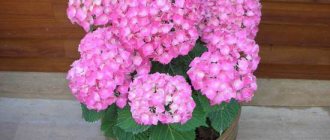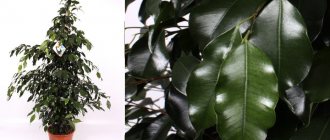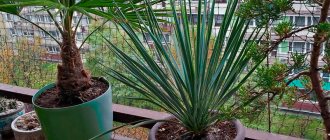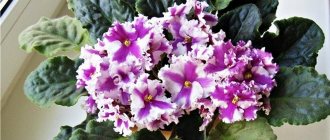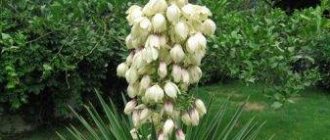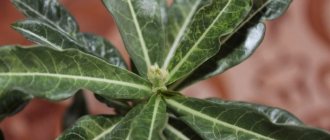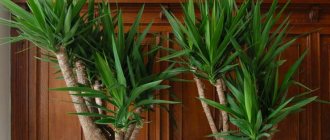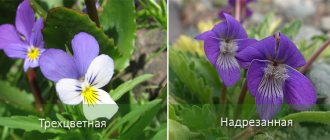Let us consider in detail the possible problems when growing yucca: why the leaves turn yellow, dry, turn black or droop. As well as pests and the most dangerous diseases that can lead to the death of a flower.
With proper care of yucca at home, the risk of pests, diseases or problems with decorativeness is significantly reduced. Therefore, maintain optimal growing conditions and carefully care for it.
It is especially important to properly water the palm tree and conduct regular inspections for prevention.
Yucca or dracaena
People often ask how to distinguish yucca from dracaena? There are species of dracaenas that look very similar to yucca, for example, Dracaena aletriformis Dracaena aletriformis or the species Dracaena massangeana (not variegated). The differences are:
- Yucca has small teeth along the edge of the leaf: noticeable roughness along the edge of the leaf, if you draw from the tip to the base
- Yucca leaves are stiffer, denser, and on young tops they stick out straight up
- The edges of yucca leaves are usually straight, while those of dracaena are often slightly wavy (the leaves themselves are softer)
- in yucca, the top of the leaf ends in a prickly spine
- Yucca's roots are reddish, sometimes quite intense in color; dracaena's roots are always white
- with the same crown size, the yucca's trunk is always thicker than that of the dracaena
Pests and diseases
Among the pests, yucca is most often affected by:, and.
Common diseases include anthracnose, yellow mottle (viral) and stem rot.
ANTHracnose
With this disease, small spots with convex brown edges and a yellow edging are visible on yucca leaves. The spots appear in a chaotic order and gradually merge into larger formations.
Control measures: stop spraying leaves and reduce indoor air humidity. Remove severely affected leaves and, if necessary, treat the palm tree with special preparations.
YELLOW MOCK (VIRAL)
The disease is manifested by the appearance of yellow specks on the leaves of the flower, especially at the tips of the leaves, most often due to aphids.
Control measures: check your home collection for aphids. Affected specimens are destroyed.
STEM ROT
This disease is caused by a fungus or bacteria that grows rapidly and makes the plant's leaves drooping, pale and soft. It appears most often due to excess moisture in the soil and poor ventilation of the room, sometimes due to hypothermia (moving the palm tree outside in winter).
Control measures: if a small part of the yucca is damaged, the affected areas must be removed. If most of it is affected, then gardeners recommend getting rid of the palm tree and pot in order to protect the rest of the indoor plants.
How to care for yucca
Question: Tell me, how to care for yucca, different sites advise differently: will it grow a trunk, or only leaves?
Natali: Yucca loves sunlight, I personally have it on a south-facing window sill, which is not shaded by trees. In winter there is always not enough light and a south window is just right. But in summer, sometimes shading may be required during the hottest hours - at noon on a sunny day. You should not place a yucca in the center of the room at all; if it is large and grows in a tub or large pot on the floor, then it should be placed by the window. It must be watered so that the soil is not wet; the top layer of soil must dry out. Water should not remain on the tray, but spray very well 2 times a day, but only in hot weather, or if there is a battery nearby. At other times there is absolutely no need to spray.
Yucca is too susceptible to overwatering - it rots easily, so make drainage at the bottom of the pot and it is high enough, with a layer 2 fingers thick.
Caring for Yucca at home - in the section of the Encyclopedia of indoor plants.
irina-bahus: Mine is on the south window, I can’t stand it on the balcony. Don't overdo it with watering and everything will be fine. A friend gave me a cutting about 10 cm from the rotten trunk of her yucca. In three years, my “cutting” became more than a meter long, and the trunk began to grow woody. You have to transship it twice a year. Yes, and in winter, when there is central heating, I spray all the flowers, including the yucca, every day. I don’t spray it in the summer, but I wash it once a week - it’s in the kitchen.
Regarding the growth rate of yucca: it will grow from a small cutting, but the trunk will not grow in height soon. On my yucca, a trunk formed after two years, now it is 5 years old, the trunk is a little more than 20 cm, and the yucca itself is 2 meters.
barsuchok: the trunk grows very slowly in height, the foliage grows faster.
Question: I transplanted Yucca after overwatering about 2-2.5 weeks ago. It stands unchanged, it has a leaf inside it, so every morning I come up and see whether it has grown or not; if it has grown, it means the crisis has passed. And another question: is it important which room, southern or western?
irina-bahus: Actually, it’s not the room, but the amount of light. There should be more light in the south, but if a house is blocked by a tree or something else, then the opposite may happen. My yucca is on the southern windowsill, it doesn’t seem to be complaining, but one of the forum members (Oksana) has a luxurious yucca in the entrance, where there is no light at all. Maybe the fluorescent lamps are on all the time, and that’s fine. I usually determine that there is very little light when the plant either begins to sharply stretch towards the light, stretch unnaturally, or stops growing altogether.
Gray: From personal experience there was exactly the same story, and with my yucca I can say the following:
- 2-3 cm depth for replanting is normal; I don’t recommend deeper - the trunk will rot!
- Very careful watering! It's better to underfill than overfill!
- No drafts!
- Optimal temperature conditions (within the limits of capabilities and actual conditions of detention).
- Do not pick or cut off the yellowed leaves, let them fall off on their own.
- Since the planting is not deep, support it with 2-3 bamboo sticks, or plastic only, not iron, metal tends to oxidize, ruining the soil!
- The most important thing is lighting! Preferably in winter from 16 to 22 hours illumination!
- If it’s not near the battery, it’s better not to spray it yet! From spring to September, it is better to place it on the balcony, but remove it from direct sun. During this period I don’t spray at all!
Yucca in the Encyclopedia
Waterlogging of the soil
Also, do not allow the soil to become waterlogged and become stagnant in the pot. Yucca loves moderate watering, so any waterlogging can cause root rot, which is very difficult to combat.
In the early stages of the disease, it will help to add new soil after cutting off all diseased roots and treating the sections with activated carbon.
If the rotting has spread to the trunk of the plant, you can root the upper part of the palm tree or take cuttings from healthy branches.
Waterlogging of yucca soil at low temperatures is especially dangerous.
.
When at rest, the plant consumes almost no water; it needs to be watered very lightly so that the soil remains slightly moist. During this period, even a single abundant watering leads to root rot.
In summer, watering yucca with cold water can lead to the onset of disease. To prevent this from happening, you need to water only with water whose temperature is 2-3 degrees higher than the room temperature.
Yucca leaves have dropped
Question: My yucca leaves don’t stick up as they should, but hang down a little (like dracaena). I spray them and water them after the soil has completely dried!
Natali: If your yucca is large, that is, the leaves are long (more than 20 cm), if it feels good and there are no signs of ill health, then such drooping of the leaves is normal. They droop as if from their own weight. However, if short leaves (up to 15-20 cm) droop, especially if they are limp, then this is due to excess moisture in the ground. It just seems to you that you are not flooding, but try to dig up the ground and touch the inside - how wet it is there. In rare cases, in the heat, the leaves may droop from drying out. Therefore, you need to rely only on the dry or wet state of the soil inside the pot.
Question: A week after the purchase, the leaves of the yucca began to dry out, then the leaves began to wilt and dry out. For some reason the small shoot just fell off, even though it was green. What am I doing wrong?
Natali: Most likely, your yucca suffered from systematic waterlogging. Yucca leaves are dense, so they look like they are drying out when overwatered, but this is a deceptive impression. Replant, inspect the roots, if you have no drainage in the pot, do it. Just replant before watering, when the soil is dry. Firstly, this makes it easier to scatter the old earthen ball, and secondly, check whether the plant has been flooded - normally, the soil should be dry before the next watering. Make the drainage high - about three fingers high, this will better protect yourself from overflow. Do not compact the new soil too much - it will settle on its own. If the lighting is good, then the yucca can be sprayed less often, every other day, every two. Yuccas suffer much more from lack of sun in winter than from dry air!
Irina-gorsh: I advise you to carefully feel the trunk. The big problem is softening of the trunk, an alarm signal. Look deeper into the soil, maybe only the top layer is dry, and the bottom layer may not have time to dry out. I have a yucca in a small pot, and I water it once a week and then sparingly, yuccas often suffer from overwatering.
sweety: When the leaves of my yucca began to droop, I changed the watering regime - practically did not water at all! I spilled it with phytosporin-m (diluted the paste). But first I replanted it in fresh soil for yuccas. I cleaned the roots, but did not wash them - I rinsed them in a bucket with diluted phytosporin. I made the drainage 10 cm (I have a high pot). After transplanting, I didn’t water it for a week.
Question: At first the yucca leaves were lush green and stretched upward, but now they are limp and pale. But recently the baby fell off. The shoot rotted right on the trunk. What can be done?
Puffy: Dry the earthen lump! Take the flower out of the pot onto the newspapers, and change its “diapers” if it’s overflow, and I think it definitely is.
Elena: An additional reason is the lack of light - if there is little light, overwatering occurs faster, more often, since with a lack of light the processes of photosynthesis and growth slow down, metabolism slows down and the need for moisture decreases, and you continue to water as if it was “working” on to the world
Main varieties
In our latitudes, several varieties of yucca are most common, which take root well in different climatic zones; the gardener is practically not required to carry out false care measures. Among the most popular:
- Filamentous yucca is a plant with large white flowers, which has practically no distinct stem.
The characteristic features of this species are long, pointed leaves with white curly threads along the edges (hence the name of the species).
This variety is resistant to cold and can be grown throughout almost the entire territory of our country.
filamentous yucca
- Glorious Yucca is a plant with beautiful red flowers.
A distinctive feature of this species is the pyramidal inflorescences. It cannot withstand temperatures below +13 degrees; it is recommended to grow this flower in warm areas with the obligatory wrapping of the stem for the winter or replanting the yucca in a greenhouse.
Glorious Yucca
- Also known in gardening are the following less common varieties: elephant yucca, aloelia, and glaucous.
Hybrids vary depending on the size of the plant, the size of the flower, and the shade of the petals.
The species retains the characteristics of its variety when the plant is propagated by any available means. The gardener only needs to correctly divide and further plant the flower, in which case he will not have problems with the young generation.
Yucca has a void in its trunk
Question: When replanting the yucca (due to waterlogged soil), I discovered a large void on the trunk under the bark. A month or a little more has passed, and now the lower leaves are turning yellow and at the same time new healthy leaves are appearing.
Irina-gorsh: If new leaves grow healthy, it means it is not bending. If the conditions for the yucca are normal (in short: cool in winter, more light, including sunlight, and infrequent watering), everything should be fine. In the future, if you are flooded, do not immediately grab the transplant, especially in winter. Depending on the root system, it is enough to take a stick selected according to the width (the thinner the better) and pierce it to the base of the pot in many places. The soil will dry out quickly and will “breathe” within a day. It’s another matter if the root system has already begun to bend, and external signs of something “wrong” with the plant appear, then when replanting, remove the “dead” roots, without touching the “live” ones, and plant in another soil.
Question: I felt the trunk, well, it seems to be hard near the ground, but in those places where the buds have died, it’s not that soft, it’s as if it’s empty.
Berry: If the trunk is hard (even with an air gap) - not all is lost, the main thing is that there is no rot, that it is not soft. You need to provide it with good light and observe it.
Natali: The yucca bark becomes looser or dries out due to changes in humidity, in this case the soil. If the soil is always evenly moist, then swelling will never occur; the bark fits tightly to the core of the stem. In one case, the bark will swell, if the yucca is heavily flooded, there is rot underneath and the plant dies. In another case, the bark begins to peel off, but the soil has time to dry out, rot does not form or dries out, the trunk develops, but the void remains. There is always an alternative - cut off the tops and root, grow a new plant.
Soil drying out
In winter, when the yucca is at rest, complete drying out of the earthen coma will not harm the plant. But in the summer, when the palm tree is growing intensively, the soil in the yucca pot should not dry out to a depth of more than 5 cm
.
However, inexperienced gardeners who know the dangers of waterlogging can water their plants very rarely. At the same time, the soil regularly dries out, which affects the appearance of the plant: the leaves dry out and turn yellow, starting from the bottom, and then fall off.
It should be remembered that yucca is not a cactus that is not afraid of the soil drying out. Its roots are different from the root system of succulents. Frequent drying out of the soil can be detrimental to the plant.
.
Yucca - reproduction
Question: My yucca is dying from waterlogging of the soil, I’m trying to propagate it: I rooted two offspring in a pot (without roots), covered it with polyethylene. I don’t know if it’s possible to make cuttings from the trunk and also root them?
Anna: Just put the cutting (cut off top) in a jar of water. Do not pour a lot of water so that the trunk is covered by no more than 1 cm, so as not to rot, and add water periodically (it evaporates). In a week, the yucca will have roots. Wait until small lateral roots of about 3-4 cm grow and plant in the ground. The main thing is, don’t overfill it in the future. But in winter, yucca needs additional lighting to root!
Alice: Yucca propagates vegetatively quite easily, but only if it is light and warm, and the biorhythms of the plant are on the rise. Try not to simply prune yucca in autumn or winter; the best time for propagation is from late January to June. It is also possible in July, if there is no heat. If the temperature is above 27C, this is also not good; the cuttings will not have enough strength to absorb moisture when the leaves quickly evaporate. Therefore, if you cut a large branch of yucca for rooting, you need to tear off some of the leaves, leaving 4-5 at most.
Impact of temperature
An alarming signal when growing a false palm at home is if the leaves of the yucca curl up.
.
Low temperatures have a detrimental effect on the life of the plant, because it comes from the subtropics and absolutely cannot stand the cold.
Under the influence of low temperatures
the leaves at the edges become brownish and gradually curl up. There are times when the temperature drops at night and the sensitive yucca freezes overnight. In winter, it is better to remove it from the windowsill in the evening until the morning, until it gets warmer.
With severe hypothermia, foliage can fall off en masse. The false palm tree does not tolerate drafts well. It is better to take care in advance that the flower is warm and cozy, especially in winter.
How to save yucca
Question: I flooded the yucca and it began to rot. How can you save what is left?
Veta: If the roots are rotten, then just try to re-root the top.
Freya: In any case, immediately remove it from the pot! If there is at least something left of the roots, cut off all the rotten ones, sprinkle the living remains with charcoal, dry them, plant them in suitable soil, and drain them well. The soil for planting is dry, do not water immediately. On the second day, water (not too much) with water containing heteroauxin or zircon. Cover with a bag (only fix the bag on the stem, not the pot!) If the roots have all rotted, try to root the top, as mentioned above.
Question: Yucca leans heavily to the side, you have to prop it up with a stick. I thought the roots had rotted, but I don’t know. Moreover, its bark does not fit tightly around the trunk. But new leaves appear normally.
irina-bahus: If you don’t like the tilt at all, try tying it to a stick and gradually straightening it. But first, look at the barrel. It should be hard. You need to really water the yucca carefully, and under no circumstances overwater it. It's better to let it sit dry. It is not necessary to spray it. But if the soil is wet, you can remove it from the pot, dry the soil a little and put it back. At the same time you will see the roots.
Causes of yellowing and drying of leaves and how to combat them
A common problem with this plant is yellowing and drying of the leaves. There are many reasons for this phenomenon in garden varieties of yucca. Among them:
- abundant watering;
- exposure to excessively hot conditions during winter;
- insufficient light for the plant.
Yellowing of the leaves of this species often indicates serious damage to the plant. You cannot ignore it, otherwise the bush will die. Basically, the appearance of brown or yellow spots on the leaves indicates that the plant is infected with a fungus.
Result of fungal infection
Measures to combat this problem are as follows:
- If the stem is damaged, it is recommended to remove the affected areas of the plant; in this case, the yucca can be saved. If a significant part of the flower has decomposed during the process of decay, it is recommended to dispose of it along with the root system so that the fungus is not transmitted to other plants.
- If the leaves are damaged, you should remove the affected leaves, stop watering for a while, transplant the yucca to a sunnier place and stop spraying the flower.
In many cases, yellowing of yucca leaves is much easier to prevent than to remove. To do this, it is enough to comply with all the requirements for watering the plant.
The tips of the yucca leaves dry out
Question: The ends of the yucca leaves dry out, this is due to lack of moisture, right?
svPooPs: Dry ends - lack of moisture only if it is hotter than 26 degrees. Then you can and even need to spray once a day. But I spray mine much less often and she doesn’t complain. The main thing is not to flood it. Water once every 1.5-2 weeks to ensure the soil dries out. Dry leaves at the bottom are normal. But there are dry ends from overfeeding with fertilizers, if the soil has become alkaline (that is, hard water and fertilizers), and if the leaves hang over the battery, from which hot air comes.
Question: In a year and a half, my yucca has grown by only 1-2 leaves. And they write that it is a fast-growing plant, and some produce up to 2-3 new leaves per week! What am I doing wrong?
IrinaP: One of the reasons is the small pot. After purchasing a plant, have a good habit of not waiting too long to replant, a maximum of two weeks. Store soil is not the best soil for yucca; peat is very hygroscopic. Systematic waterlogging of yucca goes unnoticed for the time being, the plant simply fights with all its might to prevent the roots from rotting and the growth of an insufficiently powerful healthy root mass. Make up your soil: take garden soil (calcined in the oven), add coconut substrate and zeolite for looseness, about a fifth of the volume of the pot. Yucca needs to be watered once every 1-1.5 weeks (approximately).
Ferret: If the yucca sits in a small pot, it needs to be watered every day, but the soil should have time to dry out. These are in large pots and watered once a week. But there is no need to delay replanting; after purchasing, replant in a week! And feed after transplantation in 2-3 weeks. But don't overdo it.
irina-bahus: In general, it is believed that yucca loves free pots. In any case, its root system is very powerful. But another reason for the slow growth of yucca is lack of light. This is a southern plant; in addition to feeding from the pot, it needs good light.
Diseases and natural organic processes
Yucca is very sensitive, its leaves can begin to dry out due to a simple change in location and conditions, this is always stressful for the plant.
Agave does not tolerate transplantation well, during which the developed root system is almost always injured. Perhaps after some time the plant will cope with the damage on its own and begin to develop further, stopping shedding leaves, but experts still advise using fertilizing during the adaptation period.
Improper watering will also cause the leaves to dry out. The root system of yucca is weak; if the soil becomes waterlogged, the plant will begin to rot; watering with cold water can have a bad effect on its condition. For yucca, it is important to maintain normal temperature conditions; with sudden changes in air temperature, the leaves curl and turn yellow at the tips - this is the first sign that the tree needs to be relocated.
In summer, a comfortable temperature for yucca is no more than 25°C, and in winter no less than 10°C. It is necessary to reduce the temperature gradually, starting in the fall; if by winter the temperature is not lowered to the desired level, the leaves will begin to thin out, dry out, and over time may completely fall off.
We must not forget about proper watering: in summer it should be more frequent, but in winter you should not be particularly zealous, weekly irrigation is enough - otherwise the plant will rot.
Damage to leaves can also be caused by aphids or gray mold. As a rule, midges and rot are clearly visible in the root zone and at the base of the affected leaf. To combat diseases, you need to use household insecticides.
Do not forget that the falling of leaves is also a natural process for a plant, characteristic of the stage of its intensive growth; the falling of a small number of leaves in this case should not be a cause for concern.
Our grandmothers, growing garden strawberries, or strawberries, as we used to call them, did not particularly worry about mulching. But today this agricultural technique has become fundamental in achieving high quality berries and reducing crop losses. Some might say it's a hassle. But practice shows that labor costs in this case pay off handsomely. In this article, we invite you to get acquainted with the nine best materials for mulching garden strawberries.
Succulents are very diverse. Despite the fact that “little ones” have always been considered more fashionable, it’s worth taking a closer look at the range of succulents with which you can decorate a modern interior. After all, colors, sizes, patterns, degree of prickliness, impact on the interior are just a few of the parameters by which you can choose them. In this article we will tell you about the five most fashionable succulents that amazingly transform modern interiors.
The Egyptians used mint as early as 1.5 thousand years BC. It has a strong aroma due to the high content of various essential oils, which are highly volatile. Today, mint is used in medicine, perfumery, cosmetology, winemaking, cooking, ornamental gardening, and the confectionery industry. In this article we will look at the most interesting varieties of mint, and also talk about the features of growing this plant in open ground.
People began growing crocuses 500 years before our era. Although the presence of these flowers in the garden is fleeting, we always look forward to the return of the harbingers of spring next year. Crocuses are one of the earliest primroses, whose flowering begins as soon as the snow melts. However, flowering times may vary depending on the species and varieties. This article is dedicated to the earliest varieties of crocuses, which bloom in late March and early April.
Cabbage soup made from early young cabbage in beef broth is hearty, aromatic and easy to prepare. In this recipe you will learn how to cook delicious beef broth and cook light cabbage soup with this broth. Early cabbage cooks quickly, so it is placed in the pan at the same time as other vegetables, unlike autumn cabbage, which takes a little longer to cook. Ready cabbage soup can be stored in the refrigerator for several days. Real cabbage soup turns out tastier than freshly prepared cabbage soup.
Looking at the variety of tomato varieties, it’s hard not to get confused - the choice is very wide today. Even experienced gardeners are sometimes confused by it! However, understanding the basics of selecting varieties “for yourself” is not so difficult. The main thing is to delve into the peculiarities of the culture and start experimenting. One of the easiest groups of tomatoes to grow are varieties and hybrids with limited growth. They have always been valued by those gardeners who do not have much energy and time to care for their beds.
Once very popular under the name of indoor nettle, and then forgotten by everyone, coleus today is one of the most colorful garden and indoor plants. It is not for nothing that they are considered stars of the first magnitude for those who are primarily looking for non-standard colors. Easy to grow, but not so undemanding as to suit everyone, coleus require constant monitoring. But if you take care of them, bushes made of velvety unique leaves will easily outshine any competitor.
Salmon backbone baked in Provençal herbs provides tasty pieces of fish pulp for a light salad with fresh wild garlic leaves. The champignons are lightly fried in olive oil and then sprinkled with apple cider vinegar. These mushrooms are tastier than regular pickled ones, and they are better suited for baked fish. Wild garlic and fresh dill get along well in one salad, highlighting each other’s aroma. The garlicky pungency of wild garlic will permeate both the salmon flesh and mushroom pieces.
A coniferous tree or shrub on a site is always great, but a lot of conifers is even better. Emerald needles of various shades decorate the garden at any time of the year, and phytoncides and essential oils released by plants not only aromatize, but also make the air cleaner. As a rule, most zoned mature conifers are considered very unpretentious trees and shrubs. But young seedlings are much more capricious and require proper care and attention.
Sakura is most often associated with Japan and its culture. Picnics under the canopy of flowering trees have long become an integral attribute of welcoming spring in the Land of the Rising Sun. The financial and academic year here begins on April 1, when the magnificent cherry blossoms bloom. Therefore, many significant moments in the life of the Japanese take place under the sign of their flowering. But sakura also grows well in cooler regions - certain species can be successfully grown even in Siberia.
I am very interested in analyzing how people's tastes and preferences for certain foods have changed over the centuries. What was once considered tasty and was an object of trade, lost its value over time and, conversely, new fruit crops conquered their markets. Quince has been cultivated for more than 4 thousand years! And even in the 1st century B.C. e. About 6 varieties of quince were known, and even then methods of its propagation and cultivation were described.
Delight your family and prepare themed cottage cheese cookies in the shape of Easter eggs! Your children will be happy to take part in the process - sift the flour, combine all the necessary ingredients, knead the dough and cut out intricate figures. Then they will watch with admiration as pieces of dough turn into real Easter eggs, and then with the same enthusiasm they will eat them with milk or tea. How to make such original cookies for Easter, read our step-by-step recipe!
Among tuberous crops, there are not so many decorative deciduous favorites. And caladium is a true star among the variegated inhabitants of interiors. Not everyone can decide to own a caladium. This plant is demanding, and first of all, it requires care. But still, rumors about the extraordinary capriciousness of caladiums are never justified. Attention and care can avoid any difficulties when growing caladiums. And the plant can almost always forgive small mistakes.
We have prepared a hearty, incredibly appetizing and simply easy-to-prepare dish for you today. This sauce is one hundred percent universal, as it goes with every side dish: vegetables, pasta, or anything. Chicken and mushroom gravy will save you in moments when you don’t have time or don’t want to think too much about what to cook. Take your favorite side dish (you can do this in advance so everything is hot), add some gravy and dinner is ready! A real lifesaver.
Among the many different varieties of these popular vegetables, we will tell you about three that are distinguished by their excellent taste and relatively unpretentious growing conditions. Characteristics of the eggplant varieties “Almaz”, “Black Beauty” and “Valentina”. All eggplants have medium-density pulp. In Almaz it is greenish, while in the other two it is yellowish-white. They are united by good germination and excellent yield, but at different times. Everyone's skin color and shape are different.
Let’s find out in more detail what diseases yucca is susceptible to.
Yucca - leaves turn yellow
Question: Yucca leaves are turning yellow - at first the leaves began to lose color and became very light. They don’t dry out, don’t get wet - nothing, they grow as usual, only very light in the rosette. I haven’t changed the place - it’s been standing on the north window, without sunlight for five years now. And only now it is getting brighter.
Natali: There are two options:
- The first is the lack of light. At first the yucca was small, and there was enough lighting for the entire bush. Over the course of five years, she grew up, stretched out in height, and there was not enough lighting for her. The best way to confirm this is to move it to a bright place; the leaves darken and grow larger in just a week.
- Second - if the leaves lighten from the inside of the rosette, and with yellowness, perhaps it is being flooded - dig up the soil and try to determine the moisture content of the soil inside the pot; by the next watering it should be dry.
Leah: And my yucca turned yellow in the shade, it stood in the far corner of the room, and as soon as it was moved to the windowsill, the lightening stopped, and it turned green again. I have a south side, although the balcony is glazed, but it is still very bright, and all summer it stands on the balcony with light shading, growing and making me happy.
Question: The young leaves of the yucca turn yellow, first one, then it dries up, and then the whole shoot. I have it 2 meters from the window (in the summer on a glassed-in balcony), I water it as it dries out (every other day in the summer). I fertilize rarely, about once a month (Pokon green generator, I think). The pot is approximately 25 cm in diameter, the trunk is about a meter high. All the young shoots that were there when purchased have already fallen off. There was one left on the large trunk and one on the small one. But new little ones don't come out. When replanting in the spring, I discovered that the trunk was deeply buried in the ground (7-8 cm), I dug it up a little. Now she leans over and doesn't hold well in the potty. Maybe this is the case and we need to bury it back?
Freya: The southeast is good, but 2 meters from the window is a lot, there, without additional lighting, a rare plant will feel good, but yucca is clearly not one of them - it is not a “lower floor” plant that is content with that what falls to him. As a representative of rather arid regions, it is accustomed to growing in direct sunlight. To begin with, move it closer to the window, if not on the windowsill, then as close as possible! It may simply not “pull out” young shoots due to lack of nutrition, caused, of course, by a lack of light.
Natali: Yucca should be on the south window. It doesn’t have enough light, which is why the leaves turn yellow, but most likely you have not one reason, but two - also constant waterlogging. The trunk can be buried in the ground, but to prevent rotting, dig it out of the ground, and to prevent the trunk from tilting or falling, tie a support. One important point: yucca on healthy strong roots will never collapse or fall. If it is drooping, the roots are weak, they have been flooded, there are not enough of them. You can temporarily press the trunk with a couple of stones, but the main thing is to create conditions for the growth of new roots, which will support the trunk themselves.
You need to know the enemy by sight
In addition to diseases, some insects are enemies of yucca.
Pests rarely attack a plant with strong immunity, but diseased, depleted specimens often become their target. Let's consider who can live with your pet.
Mealybug
Most often it affects a palm tree in the off-season, when the plant experiences stress from changes in temperature. Externally, mealybugs look like small cotton balls; if you crush the fluffy ball, bloody discharge appears. Its harm is enormous, since it sucks juice from leaves and branches and multiplies very quickly.
If you notice a mealybug infestation, thoroughly wipe the yucca leaves with a sponge dipped in warm, soapy water, removing all visible traces of the pest. After this, treat the plant with an insecticide (Aktara, Calypso, Fitoverm, etc.). The procedure must be repeated 3-4 times with an interval of 7-10 days.
Shchitovka
Another dangerous enemy of yucca is the scale insect. A tiny insect, similar to a small turtle, is generally mistaken by some for a growth on the leaves, since it is motionless. Having firmly attached itself to a leaf blade or cuttings, the scale insect sucks out the juices of the plant. The first sign of a dangerous neighborhood is a sticky, shiny discharge.
Not only the scale insect itself harms the flower, but also the sticky substance. It clogs the pores of living tissue, creating favorable conditions for fungal infections.
The “shell” of the scale insect is so dense that it is difficult to kill it even with chemicals. First you need to remove adult individuals mechanically - with a swab moistened with a concentrated soap solution or vodka, clean the leaves and stems of brown “growths”. Remove the top layer of soil.
After this, treat the plant with an insecticide. As with mealybugs, repeat the procedure at least 3 times.
Spider mite
Spider mites can settle on weakened plants. First, light “grains” appear on the back of the sheet, and then a thin web appears.
To combat the pest, you will need an insecticide with an acaricidal effect - Fitoverm, Vertimek.
In addition to diseases and pests, there may be other reasons why yucca leaves turn yellow -.
To increase the plant’s resistance to stress, do not neglect feeding in the summer - a balanced diet will help build strong immunity. In winter, give the yucca a rest and gain strength for the new season. Proper care is the best disease prevention.
A video about caring for yucca will help you avoid many problems.
Very often, when growing yucca, gardeners are faced with yellowing and falling of the leaves of this plant. Its leaves dry out at the tips, and then the leaf blades die off completely.
If this happens to the 2-3 lower leaves, a natural process of growth and development of the plant is observed.
But if it is rapidly losing leaf mass, it is necessary to look for the reason in improper care of this palm tree.
Yucca can lose leaves due to poor or abundant watering, too dry air and insufficient lighting. Also, the leaves may dry out and turn yellow if the plant is damaged by pests.
How to water yucca
Question: The yucca leaves have turned light green and are drooping and withering. Stands on the floor near the balcony on the south side. I spray 3-4 times a week, I water rarely, because... I'm afraid to fill it again, about once every 2 weeks. I recently fed it. The trunk is solid.
Natali: There is a catastrophic lack of light, if you don’t move it to a sunnier place, it will die like a freak. Watering may be too infrequent.
irina-bahus: Is watering once every two weeks not enough? It is better to navigate not by the number of days, but by the condition of the earth. I water when the soil on top dries out (well, at least once a week). You can also measure the acidity of the soil - suddenly it is sour, sometimes the leaves become lighter, indicating that it is necessary to spray with iron chelate. And one more thing: there is usually a draft under the balcony door, maybe put it on the windowsill for now?
Natali: To resolve the debate - to water a lot or a little, I will say right away that it depends primarily on the density, porosity and moisture capacity of the soil, as well as on whether there is a lot of free soil or roots in the pot. You need to adapt to your microclimate in the apartment and the ability of “your” soil to absorb and evaporate water. Even if two plants were planted in the ground from the same bag, the watering would still be different. Some people have a larger pot or drainage holes, others have a higher temperature in the room, more leaf mass (evaporating surface), etc.
If the roots occupy more space in the pot than the free soil, then you need to water more abundantly than if the roots occupy only a small space in the pot. And of course, for plants that do not tolerate overwatering, the soil should be checked not from above, but in the depths of the pot. Just to the depth of a finger – i.e. approximately 10-12 cm, if it is wet, do not water! Since this is technically difficult to do, I suggest determining by the weight of the pot - just remember how much it weighs approximately when the soil inside is dry.
And you also need to distinguish dying leaves:
- if they just wilt, it’s most likely due to waterlogging,
- if they curl lengthwise like a tube, then there is either not enough moisture or light.
Yucca easily tolerates fairly dry air, but will get sick if it does not have enough light. Never spare light for it - feel free to place additional lamps in the fall and winter, and in the summer on the south window. When lighting decreases in the fall, the need for watering is also sharply reduced. Everything is so subtly connected that experience comes not over months, but over years. Forget about fertilizers altogether if you are new to floriculture, just replant annually. There are as many holes at the bottom of the pot as possible, drainage of at least 2 cm. Measuring acidity will most likely not give you anything, since yucca is not as demanding of it as, for example, gardenia or azaleas, and the soil composition for palm trees is quite suitable in composition. But there is no need to allow the formation of salt deposits on the soil surface.
Plant care
Yucca is a plant that requires virtually no special care from the gardener. The most important thing when growing this species is to choose the right place for planting it, prepare the soil well, and then water and feed it from time to time. For better growth of yucca throughout the year you should:
- carry out periodic loosening of the soil: good drainage and aeration of the yucca planting site;
- for the winter, bring flowerpots with yucca into the house or wrap plants in the garden with thick paper;
- monitor the level of moisture in the soil;
- periodically treat the leaves with pest control agents.
The last point when growing a garden species needs to be given a lot of attention.
Yucca is a plant that is susceptible to pests.
Common enemies of this shrub are slugs and snails, which eat fresh leaves.
garden snail
Plant infestation with scale insects
Watering
For yucca, it is worth determining a moderate watering schedule. It must be remembered that this plant categorically does not tolerate high humidity and with poor soil drainage it dies quite quickly. To avoid overwatering the yucca, it is recommended to ensure that the plant’s soil is relatively dry and not to allow moisture to accumulate near the rhizome. In this article you can learn a lot about how care and
If you cannot determine the watering schedule yourself and are afraid of destroying the plant, focus on the general condition of the yucca. When it requires moisture, its leaves begin to curl and its threads begin to sag.
Top dressing
The plant needs to be fed once every 2-3 weeks, but only during the period of most intensive growth, especially in the summer and spring months. For this purpose, it is recommended to use standard garden mixtures for yucca. During the winter season, plants are not fertilized.
You cannot fertilize yucca if the plant has not yet acclimatized in the open ground, as well as before replanting or during illness. During such periods, your flower should be in a state of complete dormancy.
Yucca from the store, what to do next
Question: 2 months ago they gave me a yucca, I was afraid to replant it in winter. The leaves began to turn yellow, and not the lower ones, but as necessary. They turn yellow and then dry out. Recently transplanted. The root system was good, not flooded, not overdried, only the roots were intertwined: it was cramped for him. What with her?
Elena: Yucca is very light-loving and the leaves may turn yellow due to lack of light. Therefore, after purchase, the yucca should be placed in a permanent place on a sunny windowsill, but the first two weeks should be given for adaptation: do not replant and shade it from the hot sun at noon. When the yucca adapts to your microclimate (combination of temperature, air humidity, lighting), you need to transfer it (without disturbing the roots) into a larger pot, always with drainage at the bottom. And again leave it alone for a month and a half, only then can you start feeding. All this time, keep an eye on the plant; after all, you can bring pests and diseases from the store. If there are any stains, pour phytosporin several times. While it is still adapting, you can spray it with stimulants and growth regulators.
irina-bahus: This could be an adaptation. Young yucca leaves are always more light green than old ones; they then turn dark green. Now, when there is little light, it is better to place it on the windowsill, in the most illuminated place. And water less often, and it’s also good to loosen the soil so that the roots have air. And, of course, two days is not enough time to draw conclusions; we need to observe. By the way, those sheets that have begun to turn yellow will still dry out, so you don’t have to react so sharply to this.
Low humidity
If the plant is kept at room temperature in a heated room in winter, its leaves may dry out due to lack of moisture in the air.
Yucca tolerates low humidity well, but if the air is very dry and the plant is located near heating devices, then even such an unpretentious plant can begin to turn yellow.
During the cold period, you must first of all move the yucca away from the heating radiators.
. Usually this is enough for its leaves to stop drying and turning yellow. You can artificially humidify the air near the plant by placing it in a tray with damp sand, expanded clay or moss.
